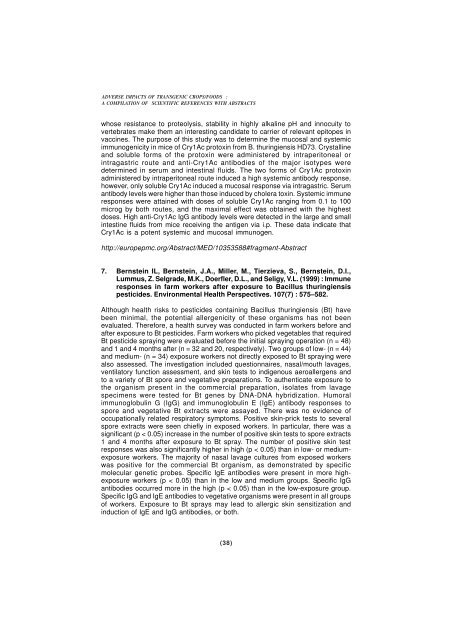omb3dyw
omb3dyw
omb3dyw
You also want an ePaper? Increase the reach of your titles
YUMPU automatically turns print PDFs into web optimized ePapers that Google loves.
ADVERSE IMPACTS OF TRANSGENIC CROPS/FOODS :A COMPILATION OF SCIENTIFIC REFERENCES WITH ABSTRACTSwhose resistance to proteolysis, stability in highly alkaline pH and innocuity tovertebrates make them an interesting candidate to carrier of relevant epitopes invaccines. The purpose of this study was to determine the mucosal and systemicimmunogenicity in mice of Cry1Ac protoxin from B. thuringiensis HD73. Crystallineand soluble forms of the protoxin were administered by intraperitoneal orintragastric route and anti-Cry1Ac antibodies of the major isotypes weredetermined in serum and intestinal fluids. The two forms of Cry1Ac protoxinadministered by intraperitoneal route induced a high systemic antibody response,however, only soluble Cry1Ac induced a mucosal response via intragastric. Serumantibody levels were higher than those induced by cholera toxin. Systemic immuneresponses were attained with doses of soluble Cry1Ac ranging from 0.1 to 100microg by both routes, and the maximal effect was obtained with the highestdoses. High anti-Cry1Ac IgG antibody levels were detected in the large and smallintestine fluids from mice receiving the antigen via i.p. These data indicate thatCry1Ac is a potent systemic and mucosal immunogen.http://europepmc.org/Abstract/MED/10353588#fragment-Abstract7. Bernstein IL, Bernstein, J.A., Miller, M., Tierzieva, S., Bernstein, D.I.,Lummus, Z. Selgrade, M.K., Doerfler, D.L., and Seligy, V.L. (1999) : Immuneresponses in farm workers after exposure to Bacillus thuringiensispesticides. Environmental Health Perspectives. 107(7) : 575–582.Although health risks to pesticides containing Bacillus thuringiensis (Bt) havebeen minimal, the potential allergenicity of these organisms has not beenevaluated. Therefore, a health survey was conducted in farm workers before andafter exposure to Bt pesticides. Farm workers who picked vegetables that requiredBt pesticide spraying were evaluated before the initial spraying operation (n = 48)and 1 and 4 months after (n = 32 and 20, respectively). Two groups of low- (n = 44)and medium- (n = 34) exposure workers not directly exposed to Bt spraying werealso assessed. The investigation included questionnaires, nasal/mouth lavages,ventilatory function assessment, and skin tests to indigenous aeroallergens andto a variety of Bt spore and vegetative preparations. To authenticate exposure tothe organism present in the commercial preparation, isolates from lavagespecimens were tested for Bt genes by DNA-DNA hybridization. Humoralimmunoglobulin G (IgG) and immunoglobulin E (IgE) antibody responses tospore and vegetative Bt extracts were assayed. There was no evidence ofoccupationally related respiratory symptoms. Positive skin-prick tests to severalspore extracts were seen chiefly in exposed workers. In particular, there was asignificant (p < 0.05) increase in the number of positive skin tests to spore extracts1 and 4 months after exposure to Bt spray. The number of positive skin testresponses was also significantly higher in high (p < 0.05) than in low- or mediumexposureworkers. The majority of nasal lavage cultures from exposed workerswas positive for the commercial Bt organism, as demonstrated by specificmolecular genetic probes. Specific IgE antibodies were present in more highexposureworkers (p < 0.05) than in the low and medium groups. Specific IgGantibodies occurred more in the high (p < 0.05) than in the low-exposure group.Specific IgG and IgE antibodies to vegetative organisms were present in all groupsof workers. Exposure to Bt sprays may lead to allergic skin sensitization andinduction of IgE and IgG antibodies, or both.(38)


